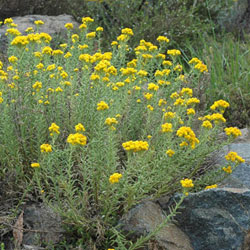Chrysocephalum apiculatum (decumbent form)
 |
 |
Common Everlasting, Yellow Buttons
Chrysocephalum apiculatum (Labill.) Steetz
Chrysocephalum apiculatum (formerly Helichrysum apiculatum) is a perennial herb which is found in all States and Territories in Australia in a wide range of environments. With such a broad distribution it is not surprising that this species varies considerably in form, from a sparse erect plant up to 60 cm in height and with narrow leaves to much lower sprawling plants with fleshy leaves 1 cm wide. The great morphological (i.e. form and structure) variation observed in plants included in this taxon suggests that there may well be several species included within the complex.
 The
form described here was collected some years ago in South Australia by the Adelaide
Botanic Gardens but the precise collection locality is unknown. This form may
properly be described as 'decumbent' which indicates that the stems lie flat
along the ground with the stem tips turning upwards. Most gardeners would consider
the form to be 'prostrate' but that term correctly refers to a plant whose stems
lie completely flat.
The
form described here was collected some years ago in South Australia by the Adelaide
Botanic Gardens but the precise collection locality is unknown. This form may
properly be described as 'decumbent' which indicates that the stems lie flat
along the ground with the stem tips turning upwards. Most gardeners would consider
the form to be 'prostrate' but that term correctly refers to a plant whose stems
lie completely flat.
The stems and leaves of this form of C. apiculatum are covered in silky hairs which give the plant an overall grey-green appearance. The stems conform to ground contours and drape over low walls and kerbs. The flowers, which appear in late spring to early summer in Canberra, occur on the tips of the stems and rise up to 15 cm above the ground in compact heads up to 2.5 cm wide. They are a golden-yellow in colour.
When planted at 70 cm centres, plants grow quickly to cover the ground and form a compact mat, however, this is seldom enough to smother the more vigorous weeds. The stems occasionally form roots where they touch the ground, though only in the most favourable conditions, and the plant is unlikely to become a nuisance.
Some pests have been noted on C. apiculatum. These are chiefly caterpillars which attack the flower buds and leaves. Control may be effected by the use of Dipel, a bio-insecticide specific to caterpillars. Aphids are also found on new shoots and the decumbent habit of this plant makes it an ideal hiding place for slugs and snails.
Propagation is easy from cuttings taken at any time of the year. Seed should not be used for propagation since it may not produce plants which are true to form.
This form of C. apiculatum is reasonably long-lived; several plantings at the Gardens are from six to ten years old. This plant performs well in a variety of garden environments though the best examples are in a fairly open situation given full sun during the middle of the day. Plants growing close to large trees tend to be more sparse than those in the open but still provide a good ground cover. The plants in the Gardens appear to be frost-hardy but drought tolerance has not been tested as all plantings have received supplementary waterings.
Text by L D Meredith, ANBG (1986)
Name meaning: Chrysocephalum apiculatumChrysocephalum - from Greek, chryso - golden and cephalus - headed; apiculatum - botanical Latin meaning 'ending abruptly in a short point', referring to the leaves. |
![An Australian Government Initiative [logo]](/images/austgovt_brown_90px.gif)

